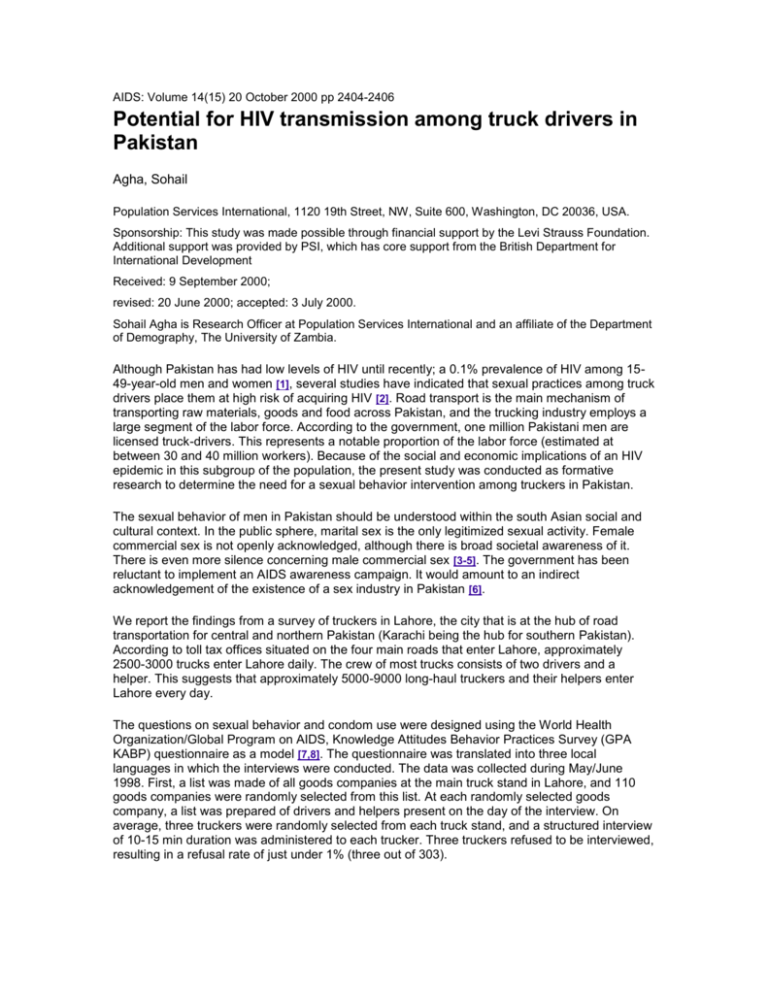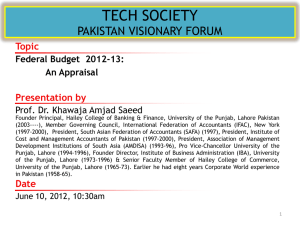
AIDS: Volume 14(15) 20 October 2000 pp 2404-2406
Potential for HIV transmission among truck drivers in
Pakistan
Agha, Sohail
Population Services International, 1120 19th Street, NW, Suite 600, Washington, DC 20036, USA.
Sponsorship: This study was made possible through financial support by the Levi Strauss Foundation.
Additional support was provided by PSI, which has core support from the British Department for
International Development
Received: 9 September 2000;
revised: 20 June 2000; accepted: 3 July 2000.
Sohail Agha is Research Officer at Population Services International and an affiliate of the Department
of Demography, The University of Zambia.
Although Pakistan has had low levels of HIV until recently; a 0.1% prevalence of HIV among 1549-year-old men and women [1], several studies have indicated that sexual practices among truck
drivers place them at high risk of acquiring HIV [2]. Road transport is the main mechanism of
transporting raw materials, goods and food across Pakistan, and the trucking industry employs a
large segment of the labor force. According to the government, one million Pakistani men are
licensed truck-drivers. This represents a notable proportion of the labor force (estimated at
between 30 and 40 million workers). Because of the social and economic implications of an HIV
epidemic in this subgroup of the population, the present study was conducted as formative
research to determine the need for a sexual behavior intervention among truckers in Pakistan.
The sexual behavior of men in Pakistan should be understood within the south Asian social and
cultural context. In the public sphere, marital sex is the only legitimized sexual activity. Female
commercial sex is not openly acknowledged, although there is broad societal awareness of it.
There is even more silence concerning male commercial sex [3-5]. The government has been
reluctant to implement an AIDS awareness campaign. It would amount to an indirect
acknowledgement of the existence of a sex industry in Pakistan [6].
We report the findings from a survey of truckers in Lahore, the city that is at the hub of road
transportation for central and northern Pakistan (Karachi being the hub for southern Pakistan).
According to toll tax offices situated on the four main roads that enter Lahore, approximately
2500-3000 trucks enter Lahore daily. The crew of most trucks consists of two drivers and a
helper. This suggests that approximately 5000-9000 long-haul truckers and their helpers enter
Lahore every day.
The questions on sexual behavior and condom use were designed using the World Health
Organization/Global Program on AIDS, Knowledge Attitudes Behavior Practices Survey (GPA
KABP) questionnaire as a model [7,8]. The questionnaire was translated into three local
languages in which the interviews were conducted. The data was collected during May/June
1998. First, a list was made of all goods companies at the main truck stand in Lahore, and 110
goods companies were randomly selected from this list. At each randomly selected goods
company, a list was prepared of drivers and helpers present on the day of the interview. On
average, three truckers were randomly selected from each truck stand, and a structured interview
of 10-15 min duration was administered to each trucker. Three truckers refused to be interviewed,
resulting in a refusal rate of just under 1% (three out of 303).
Table 1 shows the distribution of the sample. Approximately 42% of truckers were under 30 years
of age, approximately 43% were between 30 and 39 years and the rest (14%) were 40 years or
older. Approximately half (52%) had received no formal schooling. Most truckers were married
(83%), but stayed away from their wives for up 2 months at a time because of their work (not
shown).
Table 1. Distribution of the sample and percentage of truckers who ever had sex with a female or a male commercial sex
worker. *P < 0.05.CSW, Commercial sex worker.
Table 1 also shows the percentage of truckers who had ever had sex with a female commercial
sex worker (CSW), the percentage who had ever had sex with a male CSW and the percentage
who had ever had sex with a man. Approximately 34% of truckers had ever had sex with a female
CSW and approximately 11% had ever had sex with a male CSW. Approximately 49% of truck
drivers reported ever having had sex with another man.
Most truckers were not aware that condoms are an effective way of preventing HIV. Moreover,
they did not consider themselves at risk of acquiring HIV. They believed that HIV was a disease
that only affected immoral persons. The use of a condom in the last incidence of sex was
between 3 and 6% with any non-marital partner. Condoms were generally considered to be a
family planning method and their use was higher in marital sex (8%).
We concluded that Pakistani truckers comprise a segment of the work force whose sexual
practices place them at a high risk of contracting HIV. Interventions that use interpersonal
communication to convince truckers that they are at risk of HIV are needed. It is imperative that
risk-awareness campaigns directed at truckers emphasize the importance of consistent condom
use in preventing HIV transmission.
Acknowledgements
The author would like to thank Dominique Meekers, Guy Stallworthy, Helen Crowley, Karen Toll,
Jackie Gaskell and Tayyaba Hussain for their comments on an earlier version of this report.
Jackie Gaskell was responsible for the co-ordination of research activities.
Sohail Agha
References
1. UNAIDS/WHO. Pakistan epidemiological fact sheet on HIV/AIDS and sexually transmitted diseases.
June 1998.
[Context Link]
2. Ahmed AJ, Luby SP, Zia M, Pasha O, Fisher-Hoch S, McCormick JB. High prevalence of risk
factors for sexually transmitted diseases in long distance truck drivers in Pakistan. 2nd National
Symposium on Research in Basic Health Sciences and Health Care in Pakistan. Karachi, Pakistan,
September 1995.
[Context Link]
3. Khan S. Under the blanket: bisexualities and AIDS in India. In:Bisexualities and AIDS:
international perspectives. Aggleton P (editor). London: Taylor and Francis; 1996. pp. 161 -177.
[Context Link]
4. Khan OA, Hyder AA. HIV/AIDS among men who have sex with men in Pakistan. Sex Health
Exchange 1998, 2: 12 -13,15.
[Context Link]
5. Khan S. Through a window darkly: men who sell sex in India and Bangladesh. In:Men who sell
sex. Aggleton P (editor). Philadelphia: Temple University Press; 1999. pp. 195 -212.
[Context Link]
6. Haroon A. Dancers of the night. In:World AIDS, vol. 11. London: Panos Institute; November 1994.
[Context Link]
7. WHO. Evaluation of a national AIDS programme: a methods package. Geneva: World Health
Organization; 1994.
[Context Link]
8. Cleland J, Ferry B. Sexual behavior and AIDS in the developing world. London: Taylor and Francis;
1995.
[Context Link]








